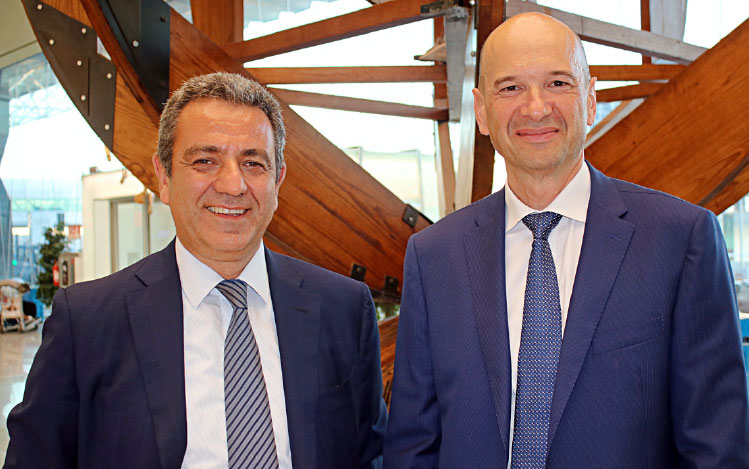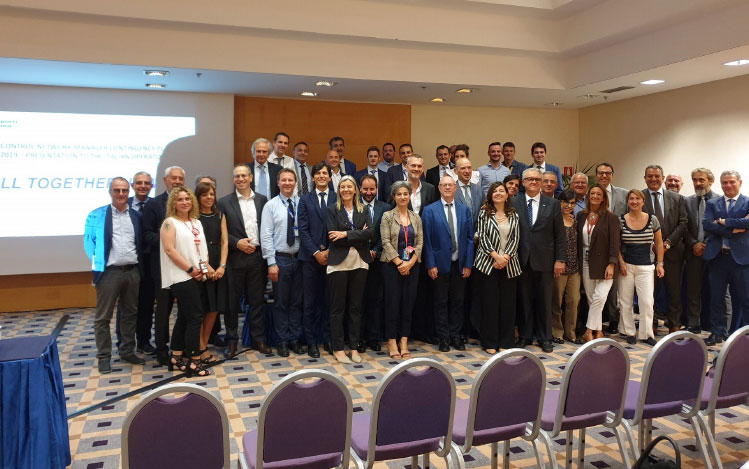Through the support of ACI EUROPE’s SESAR Related Deployment Airport Grouping (SDAG), Aeroporti di Roma (ADR), the operator of Rome Fiumicino and Ciampino airports, is participating in EU-funded projects that are deploying SESAR solutions. The aim is to streamline airports operations and, ultimately, offer a better passenger experience. Luc Laveyne sits down with ADR to hear their impressions of the work done so far.

Maurizio Paggetti, Chief Operations Officer, ENAV, and Ivan Bassato, Executive Vice President Operations, ADR for Rome Fiumicino and Rome Ciampino airports.
Aeroporti di Roma (ADR) and the Italian air navigation service provider (ENAV), together with the EUROCONTROL Network Manager, organised a conference on the impact of Air Traffic Flow Management delays on passengers and on operations at airports on 20 June in Rome. It was the first time that Italian operational stakeholders gathered together to discuss how to overcome and mitigate airspace congestion. It soon became clear that solutions for additional capacity will – at least in the mid-term (3-5 years) – mainly come from the SESAR programme. The SESAR programme is the technological pillar of the Single European Sky, the European Commission’s flagship project that aims to modernise and increase the efficiency of air traffic management (ATM) in Europe. SESAR spans from the ATM Masterplan, through to the research and development ATM solutions via public-private partnerships and on to the deployment of SESAR technology and procedures by airlines, airport operators and air navigation service providers (ANSPs) – coordinated by the industrial partnership, the SESAR Deployment Alliance.
Ivan Bassato (Executive Vice President Operations of ADR for Rome Fiumicino and Rome Ciampino airports) and Maurizio Paggetti (Chief Operations Officer of ENAV) spoke with Luc Laveyne about how the deployment of SESAR technologies is a great benefit to ADR.
How has been ADR’s experience in SESAR Deployment so far?
Ivan Bassato: We were only indirectly involved in the SESAR research & development. At the time of the set-up of the airport operators’ involvement in SESAR, ADR was not ready to step in and was not fully aware of the potential to deliver a better passenger experience through SESAR solutions. Now, instead, we are exploring any new possibilities to be on board with the major European airport operators in SESAR 3 where preparations will start in 2020.
For now, ADR is mainly involved in the deployment of SESAR solutions. For example, we are working together with ENAV in joint projects for Fiumicino Airport as well as in two joint projects with 12 to 15 other airport operators; in some other projects we are, instead, working alone. Content-wise, the involvement goes from safety, operations plans and airport operations centre (APOC) all the way to IT, System Wide Information Management (SWIM). The operations of the future will be focused on serving the passengers in the best way possible, based on shared data from all operators at the airport and from the EUROCONTROL Network Manager.
The SESAR Deployment programme has quite a significant degree of bureaucracy, but with the support of SDAG we are managing well. SESAR deployment has really brought stakeholders at Fiumicino Airport closer together for the benefit of the passengers, the operations and the Air Traffic Management Network.
How did ADR experience the joint proposals of airports (and some ANSPs) on surface management and safety nets as well as to set up Initial Airport Operations Plan (AOP)?
Ivan Bassato: Working together with 12 to 15 airports is a challenge but it is exciting and motivating. Airports, and sometimes air navigation service providers, like our own Italian ANSP, ENAV, must work together. At least in Italy, with ENAV, we are moving from working in splendid isolation, as was the case in the past, towards sound collaboration. Working together and benefiting from the experience of other airports is challenging as we know each other quite well from several ACI EUROPE lessons learned, best practice sharing and other collaboration projects.
In this way we have discovered an excellent spirit of cooperation. These joint projects – set up and supported by SDAG – not only bring technical and operational SESAR solutions, but also a wealth of lessons learned and best practices that we can use to enhance our operations.

Aeroporti di Roma (ADR) and the Italian air navigation service provider (ENAV), together with the EUROCONTROL Network Manager, organised a conference on the impact of Air Traffic Flow Management delays on passengers and on operations at airports on 20 June in Rome.
In the joint project on Initial Airport Operations Plan, we have also implemented regular best practice-sharing in several meetings per year. We have the support of ACI EUROPE, who has set up a broader APOC working group to bridge the current status and the expected status in the SESAR solutions. This will be useful for other airports that will face the same challenge in the future once the geographical scope of SESAR will be expanded.
How does ADR rate the approach of ACI EUROPE to represent the airports as one group in SESAR Deployment (via SDAG)?
Ivan Bassato: The Airport Operators CEOs in the ACI EUROPE Board took the right decision to be in SESAR Deployment as one group and not as individual airports. ACI EUROPE has been successful in setting up a dedicated structure – SDAG – to support airports in the deployment of SESAR technology and procedures.
Certainly, in the beginning, in 2014/15, airports that were not used to European programmes would have found the process to secure the necessary funding for the projects challenging.
SDAG took the challenge to set up joint projects of numerous airport operators with some ANSPs. These projects, which require real coordination and synchronisation of deployment Europe-wide, would have never been possible if airports would have been represented on an individual basis in SESAR Deployment. The implementation would been less efficient and more fragmented.
Also, in the future, airport operators will need SDAG to get the best results from SESAR Deployment and to maintain these good results in terms of information sharing.
Do you think that the revision and extension of SESAR Deployment might be very much about airport and residents?
Ivan Bassato: Yes, we are looking forward to the proposal of the European Commission regarding the revision of the SESAR Deployment Programme. Two pillars should be Airport Operations Plan and SWIM. The full Airport Operations Plan should allow all stakeholders on the airport site to act as one for the benefit of the passenger. In this way, we will move towards integrated operations of all actors at the airport. The second pillar should be SWIM, simply said the “internet” of the Air Traffic Management System. If we want to have a successful, cyber-secure, reliable and resilient data sharing link, SWIM will have to be at the forefront of things. It is a major step in the digitalisation of airport operations and the digitalisation between the local and the ATM network.
So far, only Fiumicino Airport is deploying SESAR technology. Does ADR intend to deploy some of it in Ciampino Airport?
Ivan Bassato: We are surely looking at opportunities to do it. Meanwhile, we have already installed Advanced Towers and we already comply with what has been proposed by the SESAR Joint Undertaking for the revision of the Implementing Regulation.
Has the SESAR Deployment Manager created an improved working arrangement in an environment like the airport where different stakeholders are called to a continuously improved interaction?
Maurizio Paggetti: The SESAR Deployment Manager has widely contributed to the improvement of the way different stakeholders were used to cooperating within projects. This is especially valid for the airport environment, where airport operators, ANSPs and handling companies are expected to deliver their services in an efficient and synchronised manner. A few years ago, transparent information sharing among airport stakeholders was almost impossible. Today, also thanks to the opportunity offered by SESAR Deployment Manager, ENAV and ADR have not only started to share information for an integrated operations management, but they also share airport systems. The example is the full integration of Multilateration system. The new MLAT system, managed as a completely integrated project, will be fully operational by 2020.
Integrated operations of all stakeholders at the airport will become the standard in the future. These integrated operations will be coordinated in an APOC. Does ENAV intend to join the other operational stakeholders in a joint APOC?
Maurizio Paggetti: APOC is a key milestone for the future, where all airport stakeholders shall synchronise all their activities in order to offer the best service to customers. ENAV and ADR have already started to manage airport processes via A-CDM, fully operational since March 2014. Moreover, a synergic cooperation has been established to improve operational procedures, both in normal and in contingency situations. For us, this working arrangement is at its initial stage of the APOC concept. ENAV is supporting ADR in the project under the SESAR Deployment Manager umbrella to implement APOC at Fiumicino, involving all other airport stakeholders. We are confident that such a coordinated approach will allow us to design a centre where Fiumicino Airport will be able to deliver key services to its customers.
Luc Laveyne is ACI EUROPE’s Single European Sky Senior Adviser and Managing Director of the SESAR Related Deployment Airport Grouping (SDAG, part of ACI EUROPE).







